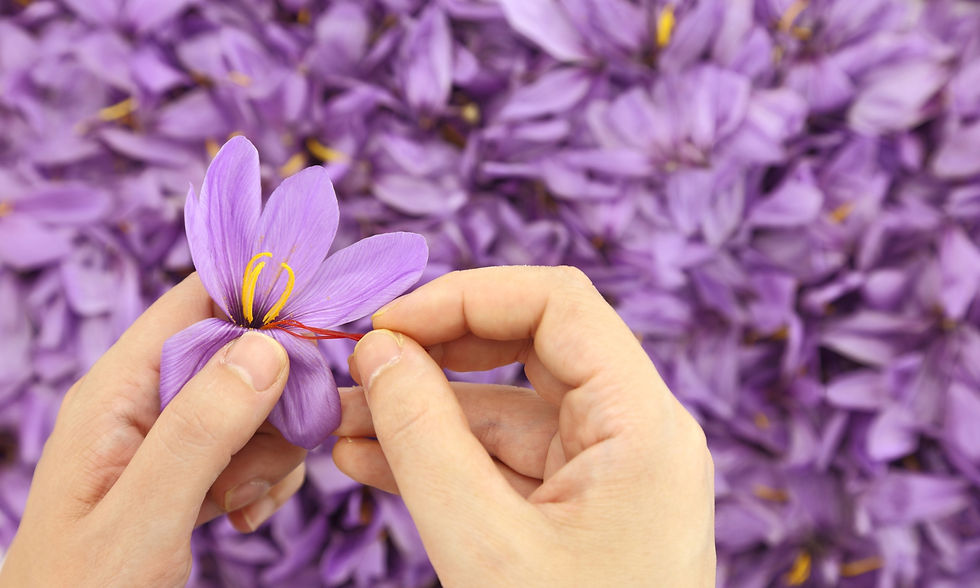The Science Behind Mangal Saffron's Premium Quality
- Siya Behrani

- Feb 3, 2024
- 3 min read
Unveiling the Secrets of Kashmiri Saffron
Saffron, the crimson stigma of the Crocus sativus flower, is a spice as old as time, renowned not just for its distinct flavor and coloring ability but also for its position as a luxury commodity in the culinary and medicinal worlds. Among the varieties of saffron cultivated around the globe, Kashmiri saffron stands out for its exceptional quality, making it highly sought after by chefs and connoisseurs alike. This blog delves into the unique attributes of Kashmiri saffron and the rigorous testing process it undergoes to ensure its purity and premium quality.
What Makes Kashmiri Saffron Unique?
1. Geographical Indication (GI) Status
Kashmiri saffron was granted the Geographical Indication (GI) tag, acknowledging its distinctiveness attributed to the geographical environment of Kashmir, including its soil composition, altitude, and climate. This status not only protects the identity of Kashmiri saffron but also reassures consumers of its authenticity and superior quality.
2. High Crocin Content
The richness of saffron is often measured by its crocin content, responsible for its potent coloring strength. Kashmiri saffron boasts a higher crocin content compared to other varieties, resulting in its intense color and flavor. Crocin is also a powerful antioxidant, contributing to saffron's health benefits, including mood improvement and potential anticancer properties.
3. Climate and Cultivation Practices
The unique climatic conditions of the Kashmir valley, with its cold winters and spring rainfall, create an ideal environment for saffron cultivation. The traditional farming practices passed down through generations, including manual labor for planting and harvesting, contribute to the high quality of the saffron produced.
Rigorous Testing Process for Purity
Ensuring the purity of Kashmiri saffron is crucial, given its high value and the potential for adulteration. The testing process for saffron purity involves several steps, utilizing both traditional methods and advanced scientific techniques.
1. Visual Inspection
The first step in assessing saffron quality involves a visual inspection. High-quality Kashmiri saffron stigmas are uniformly red, indicating minimal processing and no artificial coloring. Any presence of yellow or white parts suggests lower quality or possible adulteration.
2. Aroma and Flavor Profile
Kashmiri saffron is known for its strong and pleasant aroma, a combination of honeyed, floral, and earthy notes. The flavor is equally rich and complex, slightly sweet yet bitter. These characteristics are assessed through sensory evaluation by experts.
3. Laboratory Testing
Advanced laboratory tests play a crucial role in verifying the purity and quality of Kashmiri saffron. Techniques such as High-Performance Liquid Chromatography (HPLC) and spectrophotometry are employed to measure the concentrations of saffron's key compounds - crocin, picrocrocin, and safranal. These tests help in detecting any adulteration and confirming the saffron's geographical origin.
4. ISO Standards
Kashmiri saffron is tested against the International Organization for Standardization (ISO) standards, specifically ISO 3632, which classifies saffron based on its color strength (crocin), bitterness (picrocrocin), and aromatic profile (safranal). Kashmiri saffron often exceeds the highest category standards set by ISO, further attesting to its exceptional quality.
5. DNA Testing
To combat adulteration and ensure genetic purity, DNA testing is sometimes conducted on Kashmiri saffron. This modern technique can identify the saffron's origin and detect any biological contaminants or adulterants, ensuring the product's authenticity and purity.
Conclusion
The premium quality of Kashmiri saffron is no accident; it's the result of a unique combination of geographical factors, traditional cultivation practices, and rigorous testing for purity. This meticulous attention to detail ensures that consumers receive a product that is not only authentic and of superior quality but also packed with the health benefits and rich flavors that saffron is celebrated for. By understanding the science behind its premium quality, consumers can appreciate the value of Kashmiri saffron and the efforts made to preserve its unparalleled status in the world of spices.




Comments